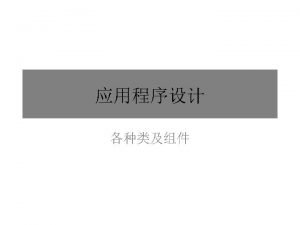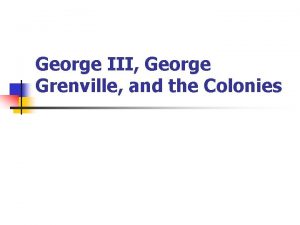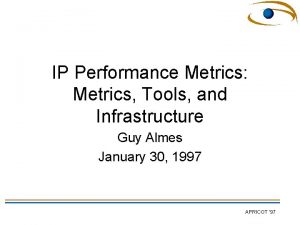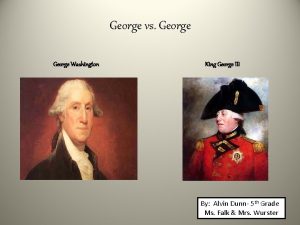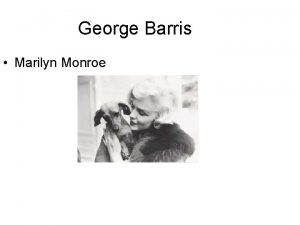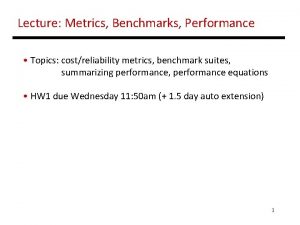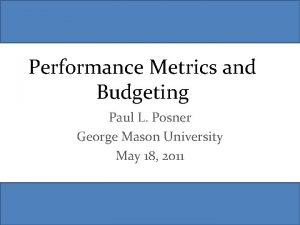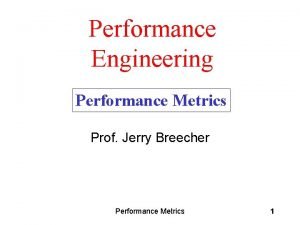System Performance Metrics and Current Performance Status George














- Slides: 14

System Performance Metrics and Current Performance Status George Angeli

Performance Metrics * Updated estimates Calibration update in-progress

Integrated Étendue − Basic definition − Extended definition • Sensitivity • Integrated étendue - Fill Factor (f. F ) - accounts for losses in the field due to masks, bad pixels, charge stops - Sensitivity Factor (f. S ) – accounts for sensitivity losses or gains due to throughput, image quality, read noise - Observing Efficiency Factor (f. O ) – accounts for losses or gains in open shutter efficiency over the entire survey

Sensitivity Factor • Not allocated - driven by allocable Technical Performance Metrics: – Image Quality – Throughput – Read noise • For each band: • Overall fs as time weighted sum Observing band (filter) Time Allocation e 2 v m. AR Depth Margin over SRD Des. f. S u band 6. 7 % 23. 7 - 0. 184 0. 712 g band 9. 7 % 24. 9 - 0. 064 0. 888 r band 22. 3 % 24. 5 - 0. 242 0. 641 i band 22. 3 % 24. 0 - 0. 001 0. 997 z band 19. 4 % 23. 4 0. 149 1. 317 y band 19. 4 % 22. 5 0. 433 2. 219 Overall 1. 185

Evolution of Image Depth Reserve in LSR above SRD Minimum Specification 0, 450 Image Depth Reserve above SRD Minimum [mag] 0, 400 0, 350 0, 300 0, 250 0, 200 PR 0, 150 0, 100 OP OS ED u band g band r band i band z band y band 0, 050 0, 000 FDR Sensitivity factor relative 1. 69 to SRD minimum specs: LSST 2014 1. 83 See Chuck’s presentation for details

Image Depth Dependencies • For each band: Image Quality Throughput and read noise 60 50 r band 40 30 20 0 7, 0 -20 -40 8, 0 9, 0 10, 0 Change since JIM Review 11, 0 12, 0 Dm 5 [mmag] 40 20 10 0 -10 350 370 390 410 430 -20 -30 -40 -60 Read noise [e-] -50 Image quality [mas] 450

Image Quality Error Budget Telescope reserve: 105 mas Camera reserve: 102 mas Total system reserve Camera charge diff. Camera cryostat height Camera raft height Camera sensor flatness Camera vibration Camera pressure Camera thermal Camera gravity Camera assembly Camera optical fab. Telescope dynamic Active optics Telescope collimation M 2 shape M 1 M 3 shape Optical design See Bo’s presentation for details of meeting this budget milliarcsecond (mas) 0 50 100 150 200 250

Evolution of IQ System Reserve milliarcsecond (mas) 250 200 150 100 50 0 PDR JIM FDR LSST 2014 Charge diffusion contribution estimate reduced before FDR from 259 mas to 186 mas

System Behavior PSF size and shape

Integrated System Model PSF size and shape Currently ZEMAX Preferably Pho. Sim

Input Parameters (Perturbations) • Deterministic effects – Optical design residual errors, – Diffraction effects due to the finite aperture and pupil obscuration, • Deterministic effects randomized by environmental and operational parameters – Mirror support print through and lens gravitational deformations randomized through telescope zenith angle – Thermal deformations of optical surfaces and support structures randomized through ambient and local temperature • Random processes Dome and mirror seeing Local actuator and sensor noise and drift (non-optical sensors) Counting statistics CCD sensor effects (solid state effects: diffusion, field dependencies, penetration depth, QE variations) – WFS measurement, estimation, and control errors – Material, fabrication, and installation errors; these become deterministic once the “as built” system is available – –

Output Parameters (Metrics) • FWHM across the field • Ellipticity across the field • Area weighted mean of 31 samples – Diffraction (FFT) PSF – Also track geometric PSF derived from spot RMS

Environmental Conditions • Fiducial atmospheres (3) – Scaled to 0. 44”, 0. 6”, and 0. 8” FWHM seeing on the aperture of LSST. • • Zenith angle range of 0˚- 65˚ – Statistical distribution derived from “standard” Op. Sim simulations. • Temperature and pressure ranges as defined in the OSS as Normal Operating Conditions. – The temperature inside enclosed volumes, like the Camera, needs to be estimated from these environmental parameters. • The expected temperature range of the detector, with assumed statistics

Future Work • Transition the optical kernel to Pho. Sim • Include missing instrumental perturbations – Most prominently sensor effects – In the process of implemented in Pho. Sim • Improve AOS control laws and performance • Establish a configuration adequate for science simulations – Linked or emulated AOS
 Strategic e-marketing and performance metrics
Strategic e-marketing and performance metrics Strategic e-marketing and performance metrics
Strategic e-marketing and performance metrics Line currents
Line currents Line vs phase voltage
Line vs phase voltage Semiconductor
Semiconductor Line current and phase current
Line current and phase current Drift current and diffusion current
Drift current and diffusion current Drift current and diffusion current
Drift current and diffusion current Balanced delta delta connection
Balanced delta delta connection Holding current and latching current
Holding current and latching current Drift current density unit
Drift current density unit King george vs george washington
King george vs george washington George washington vs king george iii venn diagram
George washington vs king george iii venn diagram Intranet performance metrics
Intranet performance metrics Key performance indicators template
Key performance indicators template















